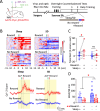Nucleus accumbens dynamics in food reward seeking and regulation by sleep
- PMID: 40593485
- PMCID: PMC12218339
- DOI: 10.1038/s41398-025-03442-z
Nucleus accumbens dynamics in food reward seeking and regulation by sleep
Abstract
Reward-seeking behavior is essential for survival and is greatly influenced by experience, internal states, and physiological factors such as sleep. The nucleus accumbens (NAc) is reward processing hub that integrates external and internal signals to regulate reward-seeking behaviors. However, it is not well understood how NAc activities during reward seeking may be shaped by learning experience, and to what extent that it may be subject to physiological regulations such as sleep. Here, we used in vivo fiber photometry to monitor calcium (Ca2+) activities in the NAc of male and female mice undergoing sucrose self-administration (SA) training. We found that the NAc Ca2+ dynamics during sucrose SA were related to the behavioral outcome and evolved over different training stages. Moreover, acute sleep deprivation increased sucrose SA while reduced NAc Ca2+ responses and dampened its sensitivity to reward update. Thus, our findings suggest that the NAc response during natural reward seeking is dynamic, adaptive to learning experience, and can be blunted by acute sleep deprivation.
© 2025. The Author(s).
Conflict of interest statement
Competing interests: All authors declare no conflict of interest. The content is solely the responsibility of the authors and does not necessarily represent the official views of the National Institutes of Health. Ethics approval and consent to participate: All animal usage was in accordance with protocols approved by the Institutional Animal Care and Use Committees at the University of Pittsburgh (#24024571). This is an animal study only, and informed consent to participate is not applicable. All authors have given their consent for the publication of this study.
Figures




Similar articles
-
Limbic-motor integration by neural excitations and inhibitions in the nucleus accumbens.J Neurophysiol. 2017 Nov 1;118(5):2549-2567. doi: 10.1152/jn.00465.2017. Epub 2017 Aug 9. J Neurophysiol. 2017. PMID: 28794196 Free PMC article.
-
Sleep deprivation engages the orexin/hypocretin system to regulate food reward seeking.Int J Neuropsychopharmacol. 2025 Aug 1;28(8):pyaf047. doi: 10.1093/ijnp/pyaf047. Int J Neuropsychopharmacol. 2025. PMID: 40613271
-
Temporal dynamics of nucleus accumbens neurons in male mice during reward seeking.Nat Commun. 2024 Oct 28;15(1):9285. doi: 10.1038/s41467-024-53690-8. Nat Commun. 2024. PMID: 39468146 Free PMC article.
-
p38 MAPK signaling in chronic obstructive pulmonary disease pathogenesis and inhibitor therapeutics.Cell Commun Signal. 2023 Nov 2;21(1):314. doi: 10.1186/s12964-023-01337-4. Cell Commun Signal. 2023. PMID: 37919729 Free PMC article.
-
Self-management of oral anticoagulation therapy--methodological and clinical aspects.Dan Med Bull. 2011 May;58(5):B4284. Dan Med Bull. 2011. PMID: 21535992
References
-
- Balleine BW. Neural bases of food-seeking: affect, arousal and reward in corticostriatolimbic circuits. Physiol Behav. 2005;86:717–30. - PubMed
-
- Kelley AE. Ventral striatal control of appetitive motivation: role in ingestive behavior and reward-related learning. Neurosci Biobehav Rev. 2004;27:765–76. - PubMed
-
- Mogenson GJ, Jones DL, Yim CY. From motivation to action: functional interface between the limbic system and the motor system. Prog Neurobiol. 1980;14:69–97. - PubMed
-
- Robbins TW, Everitt BJ. Neurobehavioural mechanisms of reward and motivation. Curr Opin Neurobiol. 1996;6:228–36. - PubMed
MeSH terms
Substances
Grants and funding
LinkOut - more resources
Full Text Sources
Miscellaneous

